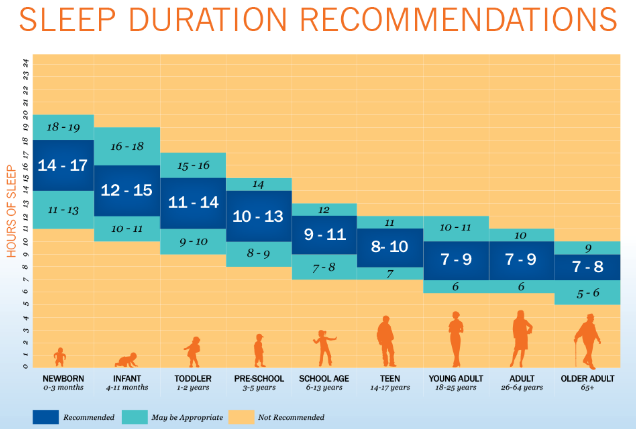It is a common question we get from our clients:
“What are some good food options for my children?”
This is a conversation that I love having (only when asked). Food is often a tougher conversation to have with people than politics or religion, ESPECIALLY when the subject is someone’s child. To dig into nutrition for children, like adults, we must first understand and implement the “low hanging fruit”. Refer back to our article on Basic Lifestyle Guidelines and a starting point.
Sleep
Sleep is vital to the growth and development of our children. Sleep hygiene is important and may set children up for long-term success by creating good habits. Create a bed-time routine and stick to it!
Below is the recommended sleep by age (National Sleep Foundation).
Newborn (0-3 mo): 14-17 hours
Infant (4-11 mo): 12-15 hours
Toddler (1-2 years): 11-14 hours
Pre-School (3-5 years): 10-13 hours
School Age (6-13 years): 9-11 hours

Play
Just like adults, the amount of physical activity plays a role in how much our children should be eating (we will dig into this when we get into nutrition).
Why is staying active important for our children?
- Active children are less likely to be overweight
- Staying active may reduce the chances of developing chronic disease (type 2 diabetes)
- Running and jumping help our children develop movement patterns that set the baseline to develop general athleticism and the ability to grow strong bones and muscles.
- Moving and being athletic can help our children’s confidence and how they feel about themselves.
Most of us (myself included) would love for our children to be world class athletes, but it is important to not pressure our kids to be great at any one sport (avoid vicariously living through your child)-we’ve all seen a situation like this and it usually does not turn out well! Avoid “specializing” in any one sport or activity. Different sports use different motor patterns that may help to maximize abilities the and if our children decide to specialize in one sport later in life.
Check out the article "Start em' Young" from OPEX HQ that goes deep into sports progressions for youth.
Nutrition
Unless there are health considerations to consider, nutrition for our children should be simple! A few things to consider:
- Opt for a wide variety of whole food sources to get the best bang for their buck micronutrient-wise
- Kids love colors! Take advantage of this with adding colorful fruits and vegetables with their meals
- Introduce these foods EARLY! Our children’s taste buds and “favorite foods” are developed with the foods that we give them
- Allow you kids to pick produce at the grocery store and help prepare their meals at home
- Give children choices, for example: “Would you like broccoli or cauliflower with dinner?”
- Do not “force-feed” healthy foods to kids, if they don’t enjoy the taste of broccoli, offer another green vegetable that they might enjoy. If we constantly force-feed that may lead to them always having negative feelings toward that particular food.
- Make food fun! Cut into shapes, different sizes, etc.
- Encourage your kids to try new foods, be patient with them if they don’t like it.
- Encourage your kids to chew their food, take their time and don’t force them to finish everything on they plate. This may teach kids that they should eat, even when their bodies are telling them they are full. Instead, save it for later (They will get hungry again...eventually).
- When eating out-ditch the “kid’s menu”. In most cases this is filled with fried, low-quality foods that most of us wouldn’t eat ourselves. So why allow our kids to? Ask for a high-quality entree and see if they can lower the portion, share with them or just take the extra home.

MyPlate does a great job giving us some general principles and direction in terms of nutrition for kids. Although not perfect, it's a step in the right direction in my opinion.
There are many healthy options out there that our kids can enjoy just as much, if not more, than their low-quality counterparts.
- Margarine or low-quality cooking oils—>High-quality butter and coconut oil
- Sweetened, high sugar yogurt—>Full fat, quality plain yogurt w/ fresh fruit and nut butter
- Cereal—>Homemade Oatmeal
- Sugary Trail Mix—>Homeade Trail Mix (nuts/seeds, dried coconut, dark chocolate nibs)
- Battered Chicken Nuggets/Tenders—>Grilled Chicken Nuggets/Tenders
- French Fries—>Roasted Potatoes (purple sweet potatoes are excellent here)
- Ice Cream/Frozen Yogurt—>Fresh smoothies with heavy cream to give the “ice cream texture”
- Sugary Drinks/Soda/Juice—>Water
I could go on and on, but I think you get the point. The big take-away here is that we must prioritize our children’s health and nutrition is an easy way to instill great habits.
If you ever wondered how much your kid should be eating, MyPlate Calculator is a great resource to help you get started.
Remember, kids are just like us, they need the nutrients that we need (even more actually because of growth and development), and deserve to be set up success by us, the parents.
If you have any questions, please contact us at here at OPEX Leander!

